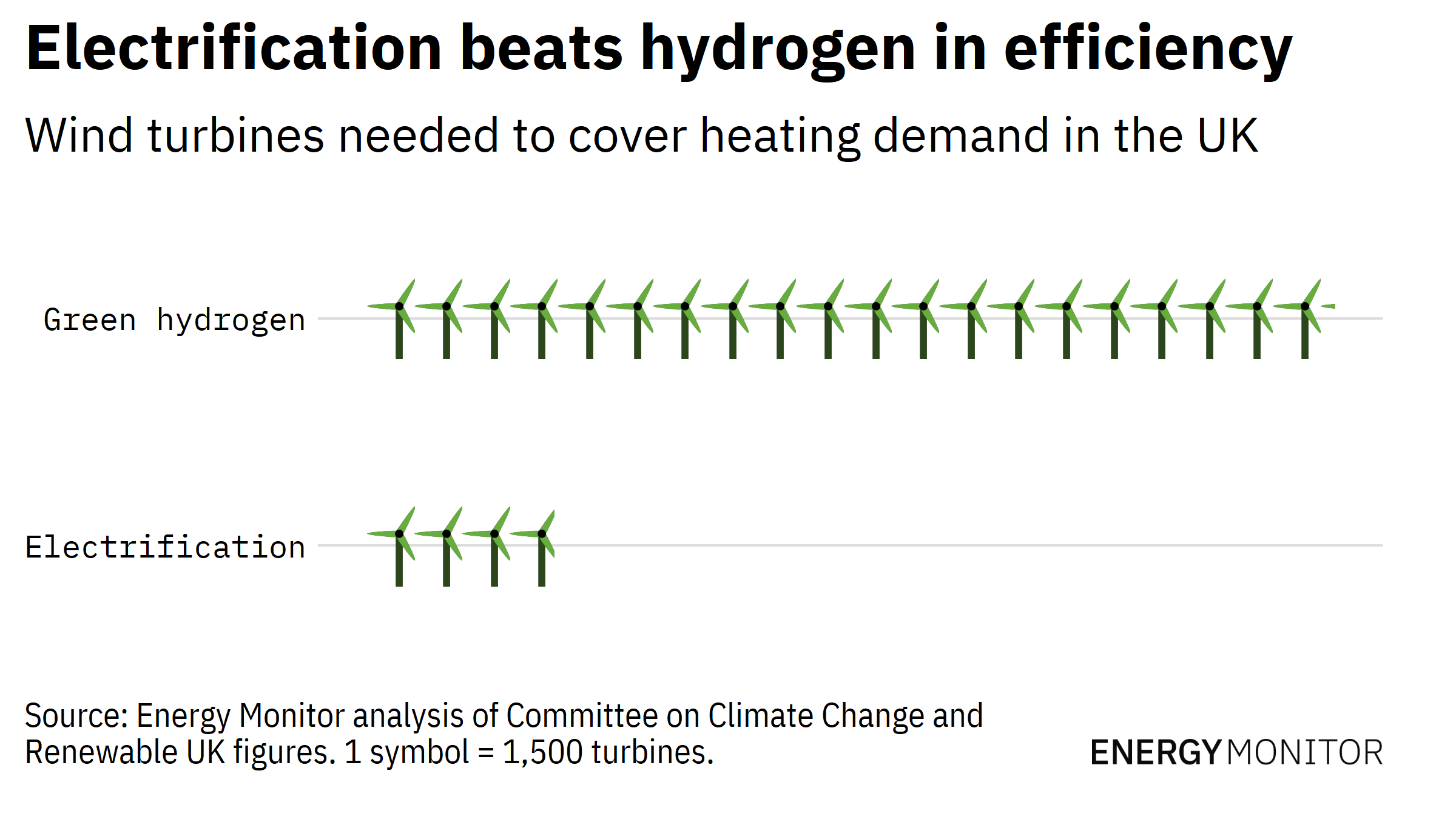Hydrogen has an important role to play in the clean energy transition, but there are better options for decarbonising heating in our homes.
The expression ‘to sell someone a pup’ comes from an old confidence trick, where a bag purportedly containing a piglet would be sold, only for the new owner to discover that it actually contained a puppy. It was a cruel deception at a time when a piglet to fatten would have been hard-won and prized – and there is a danger that proposals to heat homes with hydrogen are also offering a solution worth much less than first appears.
Net-zero emissions targets mean there is no space in future energy systems for the continued use of fossil gas, including for heat in buildings. The gas industry is quite rightly worried about what this means for its business, but hydrogen appears to have thrown a lifeline to the gas industry by trying to sell the idea that we can simply replace fossil gas with hydrogen using existing gas infrastructure. However, there is rarely a simple solution to a complicated problem.
Using hydrogen for heating our buildings at scale is problematic for various reasons.
Gas industry representatives frame hydrogen as a low-cost, no-disruption option.
This is an attractive narrative for policymakers for several reasons, not least because it suggests the possibility of a low-cost transition to net zero that consumers will barely notice. Consumers will notice and have to engage if suitable alternatives – reducing heating energy needs through energy efficiency, electrification with heat pumps and heat networks using renewable heat and other low-carbon sources – are to become mainstream, as the energy transition requires.
However, gas industry claims that clean alternatives are too expensive, too difficult and too disruptive are overblown. In reality, the alternatives are getting cheaper, more functional and easier to use every day.
Gas industry representatives frame hydrogen as a low-cost, no-disruption option. But there is rarely a simple solution to a complicated problem.
This is not to say that hydrogen cannot play an important role in the energy transition. Hydrogen from renewables is a valuable energy carrier with many specific applications where there are few alternatives. Hydrogen will be needed in large quantities to decarbonise industrial sectors, such as chemicals, and shipping. In addition, there may be a role for hydrogen to generate electricity during times when production from renewables is not sufficient. However, costs and efficiency losses will most likely be limiting factors to following this ‘power-to-gas-to-power route.’
Problematic at scale
Using hydrogen for heating our buildings at scale is problematic for various reasons.
First, producing “green hydrogen” from electrolysis is extremely wasteful compared with using renewable power directly to run heat pumps or electric vehicles. It takes about five times more wind or solar electricity to heat a home with hydrogen than it takes to heat the same home with an efficient heat pump. As a result of this inefficiency, the required build rates for renewables would be extremely challenging, a fact the UK Committee on Climate Change points out in its comprehensive review of the future of hydrogen.

Building renewables to replace fossil electricity is happening too slowly to meet climate goals. It seems highly improbable Europe has the money and land to build five times as many turbines and solar panels just to keep old fossil gas mains in use.
Secondly, green hydrogen is not cheap and is expected to cost around €0.1 a kilowatt hour (kWh) in 2030 at the point of production, according to recent research by the International Energy Agency. At a national level, the UK Climate Change Committee has produced very similar figures. This figure is significantly more than current residential gas prices in many European countries.
Diverting limited green hydrogen supplies to the building sector would also drive up the cost of hydrogen for key industries where it will be uniquely needed. The widespread use of green hydrogen in the buildings and transport sector could lead to a doubling of hydrogen costs due to higher demand, shows analysis by the energy consulting firm Aurora.
Innovation and further drops in the costs of renewable electricity will, of course, lead to lower hydrogen costs in the future, but the majority of the cost of producing hydrogen via electrolysis is the cost of the input electricity (80%–86%), rather than capital or operating costs. This means that the cost difference to direct electrification will remain similar.
Thirdly, there is also the mirage of blue hydrogen, which converts fossil gas to hydrogen, but requires carbon capture and storage (CCS) to permanently store the resulting greenhouse gas emissions. It would result in remaining carbon emissions of 15%–40%, part of which are upstream emissions in regions where gas is extracted, as revealed by recent satellite data.
Starting with blue hydrogen, hoping for green hydrogen to be available, is a high-risk strategy and faces the same cost challenges in the long term as a pure green hydrogen pathway. Similar solutions were being suggested for the coal industry 15 years ago when it became clear coal power plants were no longer acceptable given their high carbon emissions. The coal industry responded by coining the term ‘clean coal,’ suggesting every coal power plant could be fitted with CCS. Most projects based on the idea of clean coal failed to deliver and coal is now increasingly being pushed out by wind and solar.
Fourthly, converting a gas grid to a hydrogen grid is not as simple as just putting a new gas in the pipes network. Hydrogen is a different gas with different properties. It can corrode older pipes and leaks more in newer pipes. It is highly flammable but, at present, undetectable by human senses when leaking. It also requires existing gas meters and the burner tips in home appliances, and sometimes the whole appliance, to be replaced. This is a huge task, as pointed out by research commissioned on the logistics of a conversion to hydrogen.
Heat pumps and balancing
This is not to say there is no application for hydrogen in heating. Hybrid heat pumps may play a role using a small amount of hydrogen as backup during long cold spells. Hydrogen may also play a role in balancing the electricity system and indirectly support heat electrification in this way.
However, even if hydrogen becomes available in large quantities and at lower costs than expected, is will not play a large role in decarbonising heating systems any time soon. Centrica, the world’s oldest and Britain’s largest gas utility, recently said “domestic hydrogen use is likely more than ten years away, with the costs to customers as yet unknown”.
Rather than relying on unfounded promises, energy efficiency, smart electrification and district heating can deliver real carbon savings today. Analysis by the Regulatory Assistance Project provides an outline of a clean future for heating. Accelerating efficient and electrified heating can help accommodate a growing share of renewables and provide benefits to consumers and the energy system as a whole. Heat policy for the next decade should focus on solutions that are already available.
A version of this article originally appeared in Energy Monitor.

